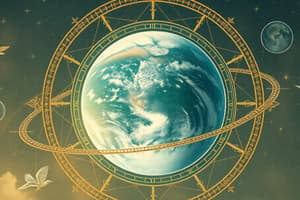Podcast
Questions and Answers
What is the duration of one complete rotation of the Earth, measured as a sidereal day?
What is the duration of one complete rotation of the Earth, measured as a sidereal day?
- 24 hours, 0 minutes, and 0 seconds
- 23 hours, 56 minutes, and 4 seconds (correct)
- 23 hours, 50 minutes, and 0 seconds
- 365 days, 5 hours, and 49 minutes
What celestial plane does the Earth follow during its revolution around the Sun?
What celestial plane does the Earth follow during its revolution around the Sun?
- Galactic plane
- Equatorial plane
- Ecliptic plane (correct)
- Axial plane
Which of the following best describes Earth's small-scale motions?
Which of the following best describes Earth's small-scale motions?
- Movement along with the Solar System
- The solar system's movement through interstellar space
- Changes in Earth's position relative to the Sun (correct)
- The revolution of Earth around the Milky Way
What is the primary purpose of Earth's revolution around the Sun?
What is the primary purpose of Earth's revolution around the Sun?
Which of the following statements correctly describes a leap year?
Which of the following statements correctly describes a leap year?
Flashcards
Earth's Rotation
Earth's Rotation
The spinning of Earth on its axis from west to east.
Earth's Revolution
Earth's Revolution
Earth's movement around the Sun in a specific plane.
Solar Day
Solar Day
The time it takes for Earth to rotate once, relative to the Sun, which is 24 hours.
Sidereal Day
Sidereal Day
Signup and view all the flashcards
Leap Year
Leap Year
Signup and view all the flashcards
Study Notes
Planetary Motions
- Earth experiences several motions in space with varying magnitudes
- Motions can be categorized into large-scale and small-scale
- Large-scale motions include Earth's movement within the Solar System and galaxy, and the revolution of the Solar System around the Milky Way
- Small-scale motions cause changes in position related to the Sun and are the basis of day-night cycles and seasons
- These small-scale motions are rotation and revolution
Rotation
- Earth rotates on its axis from west to east
- This rotation defines the North Pole, South Pole, and Equator
- One complete rotation (sidereal day) is 23 hours, 56 minutes, and 4 seconds
- The basic unit for measuring time is the solar day, which is 24 hours
- Rotation is the basis of our calendar day and causes the apparent west-to-east movement of the sun, moon, and stars
Revolution
- Earth revolves around the sun; this revolution forms the basis of our calendar year
- One complete revolution (tropical year) takes 365 days, 5 hours, and 49 minutes
- For convenience, years are typically 365 days, with an extra day added to some years (leap years)
- Earth's orbit is on a plane called the ecliptic, similar to the orbits of other planets
- Earth's axis is tilted at 23.5 degrees from the perpendicular to the ecliptic plane
Studying That Suits You
Use AI to generate personalized quizzes and flashcards to suit your learning preferences.
Description
Explore the dynamics of Earth's movements in space through this quiz. Understand the differences between large-scale and small-scale motions, focusing on Earth's rotation and revolution. Test your knowledge on how these motions impact day-night cycles and the calendar year.



